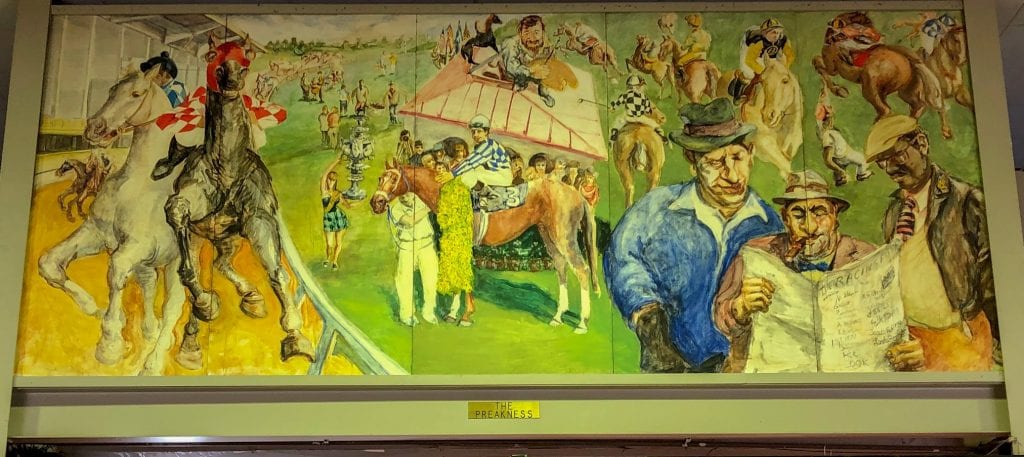At Pimlico “idiosyncratic” murals add “flavor of racing”

Pimlico murals – the Preakness.
Like a lot of older facilities, Pimlico has its challenges: a balky elevator here, a broken water main there, and of course the thousands of condemned seats in the old grandstand. But — also like a lot of older facilities — turn the corner and you might find unexpected delights.
On the second floor of the grandstand at Pimlico, there atop the betting windows, above eye level so that you might not even notice if, say, your head is buried in past performances, there’s a mural. Actually, there are seven — but let’s start with the first one.
It’s called “The Preakness.” In the foreground on the right side, three crusty old bettors, one chomping a cigar — does anyone chomp cigars anymore? — pore over a tout sheet. On the left, two horses gallop headlong towards us, one in red and white, the other in blue and white.
In the middle distance, in the center of the frame, is Secretariat, wearing the blanket of black-eyed susans. Nearby, Miss Preakness poses with the Woodlawn Vase, which seems almost to be trying to float away.
And behind Secretariat — winner of the 98th Preakness, in 1973 — is the cupola formerly on the old clubhouse. Winning connections crowd onto it, and atop is a bearded fellow set to paint the weathervane, as per tradition, in the colors of the Preakness winner.
Stop at the bearded gent for a moment. He’s holding a paintbrush and a pallete, and a knowing smile seems like it’s about to break free.
The mural is a riot of colors and shapes and perspectives, each element evocative of motion, of impermanence, familiar and yet obedient to a curious physics not quite our own.
And that painter? Well, let’s call this, for our purposes, “Portrait of the artist as a young man.”
That painter, the young man of the mural, is named Raoul Middleman. The Baltimore native, 84, retired just the other week after 56 years teaching at the Maryland Institute College of Art (MICA), and he was the driving force behind a project that provided Old Hilltop with a series of seven murals depicting different elements of the Thoroughbred industry.
In addition to the Preakness, you’ll find “The Paddock,” “Morning Exercise,” “Backstretch,” “Starting Gate,” “The Auction,” and “The Blacksmith.” Each except the last is eight feet high by 20 feet wide; The Blacksmith has had two of its five panels removed to accomodate an HVAC vent, such being the lot of public art.
“Mural is different than easel painting because it goes in a public place,” Middleman says in the days before the 2019 Preakness. “It’s somewhere between fine are and sort of commercial; it has a public function.”
The project came about in the mid-1970s when Rosalee Davison, the daughter of Pimlico’s owner, Ben Cohen, approached Middleman about painting some murals in the infield tunnel. Middleman demurred. “Too vulnerable,” he described the proposed location.
They agreed on a different spot — where they now reside — and Middleman turned the project into a class at MICA. Each took a year to complete, thus providing seven classes with a lasting presence at Old Hilltop.
“I think it was a great experience – sort of a taste of things,” says Bob Salazar, who in 1982 worked on The Auction, which was the final of the set. “You could see the whole transaction happening.”
That transaction — from commission to execution to placement — was more reminiscent of an earlier era, one prior to our notion of a starving artist, from when artists, well, earned a living with their art.
“I think it was really important to be part of that commercial experience,” adds Salazar, “a challenge in really good, important ways.”
Middleman says that call to an earlier era was purposeful.
“The students would work on it, and I would work on it,” he recalls. “It was a different kind of class — like an old Renaissance workshop in which students sacrificed their individual goals for the project.”
At the same time, both men agree, the vision executed was Middleman’s. During the first half of the year, the class would visit the racetrack frequently to learn about the subject matter. Then they would move to creating the work.
“To keep it unified, I would draw the mural,” Middleman explains. “Each one had a specific idea, and I would draw it up in small scale.”
From there it would be transferred to the larger masonite panels and painted with egg tempera, a long-lasting, fast-drying medium that has been in use for thousands of years.
“Because this was being done for a commercial client, it had to last,” Salazar notes.
Not without some hiccups. There’s the (not so) small matter of the two panels removed from The Blacksmith. Another time there was chatter about painting them over altogether. And there’ve been the generations of bettors who paid them no mind, heads buried in programs, wallets at the ready.
Middleman’s racetrack is, in some ways, Runyonesque — the raffish charm, the quirky and difficult characters, the fluid and yet ferocious grace of the Thoroughbred. And in the same breath, he recalls with a kind of wistful fondness the days when his mother and Aunt Alice would come to the track, which he says then had “high style.”
In The Auction, on which Salazar worked, a bow-tied auctioneer is in the midst of hammering down a sale, a cold-blooded look on his face. Elsewhere, an overalled man shows a horse, a bidder slyly raises his hand, a consignor struggles to hang on to a bucking animal. In the foreground, on the bottom right of the mural, a fellow has his head buried in a newspaper, the text of which is actually the names of the students who worked on the project, Salazar’s at the top.
In Backstretch, a trainer leads a horse towards us, a female rider on its back. Elsewhere, a horse is getting bathed, another its teeth checked, a third its hoof picked. It’s a racing world in miniature.
And then there’s Starting Gate, with its horses nervously awaiting their moment, the gate crew trying to move one in, the red-jacketed outrider, the owner in pearls and fur. Middleman says that then-starter Eddie Blind used to let his students into the infield to get up close to sketch the horses and gate crew.
“I don’t think there’s any more exciting moment in sports than the moment, just tumbling out of the gate,” Salazar says.
Salazar calls the murals “pure Middleman,” and Middleman doesn’t dispute that.
“My own feeling about the murals is that they were some of the best things that ever came out of my imagination,” he says, which, when you see the dozens of exhibitions he’s mounted, the awards he’s won, is saying something.
But perhaps it’s not surprising. As a teenager, he worked for old-time trainer Jimmy Hector, just one part of his equine education.
“It was a personal thing for me since a lot of my teenage life was spent around horses,” Middleman says. “The murals are unique. They’re a little idiosyncratic to racing. I wanted the perspectives to jump around, so you see a multitude of shots into the energy of the racetrack. They have the flavor of racing.”
If the murals have faced challenges over the years — and they have — one that worries Middleman even more today is the fate of the racetrack in which they reside, and what that might mean for his work.
“I don’t know what’s going to happen,” he says. “I’d like to see them preserved. I’d hate for them to be lost. It’s sad. Pimlico was such a Baltimore fixture. Racing was a great thing.”
“That would be the best thing for Baltimore — to keep the track going and keep it there,” Salazar agrees. “If not, I’d like to see them go somewhere and still be displayed. I think they could go to another track and still be viable, still be contemporary.”
Over the weekend, another, oh, 150,000 or so people will traipse through Pimlico. Most probably will never visit the second floor of the grandstand. Many who do will never look up. But some — hundreds? thousands? — will glance up and enter, for a moment, the racing world as Raoul Middleman sees it. And if they do, they’ll smile as they pass their money to the teller for the next bet.
“I love the track. I love the people,” Middleman says. “It was a world where rich and poor collide.”







